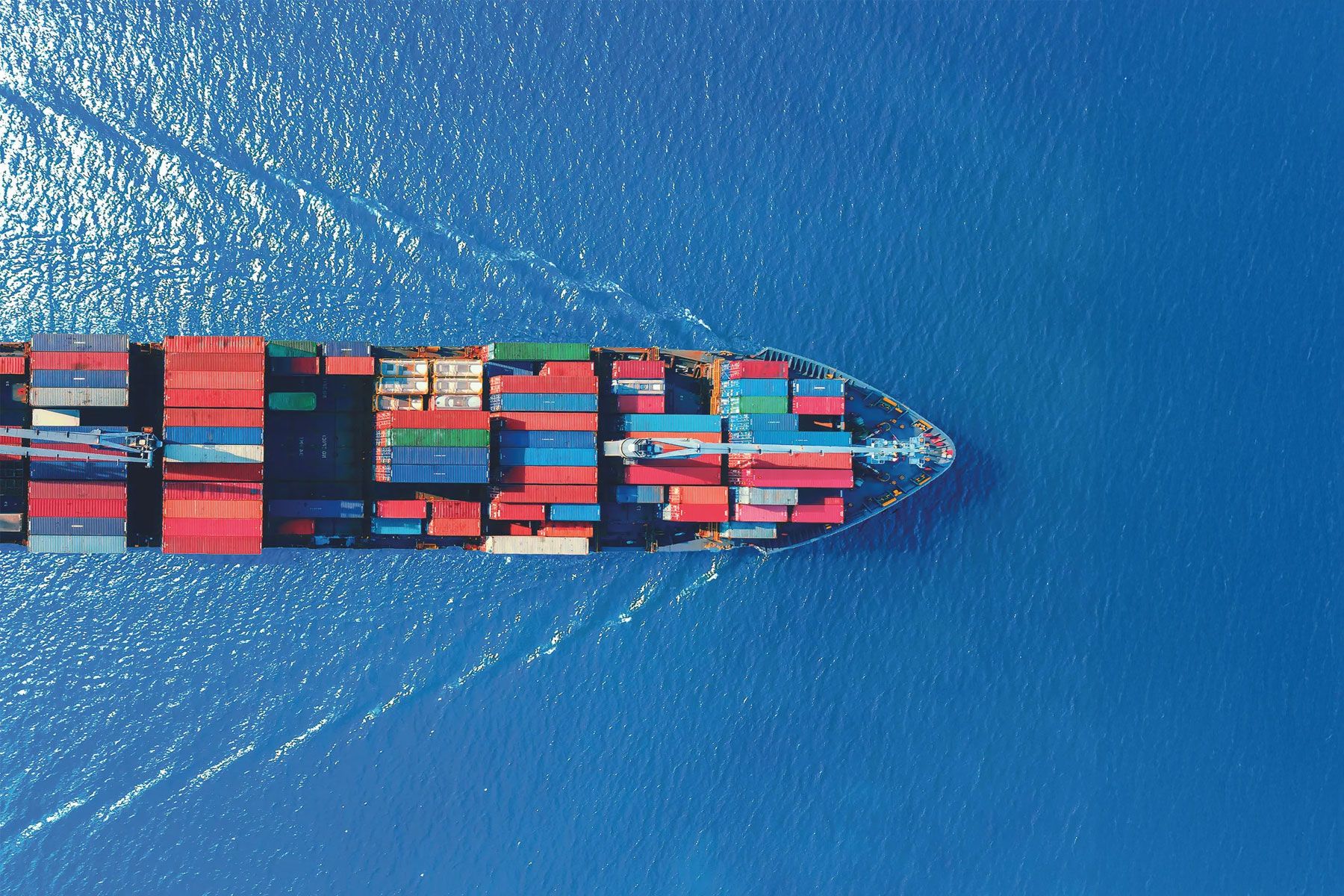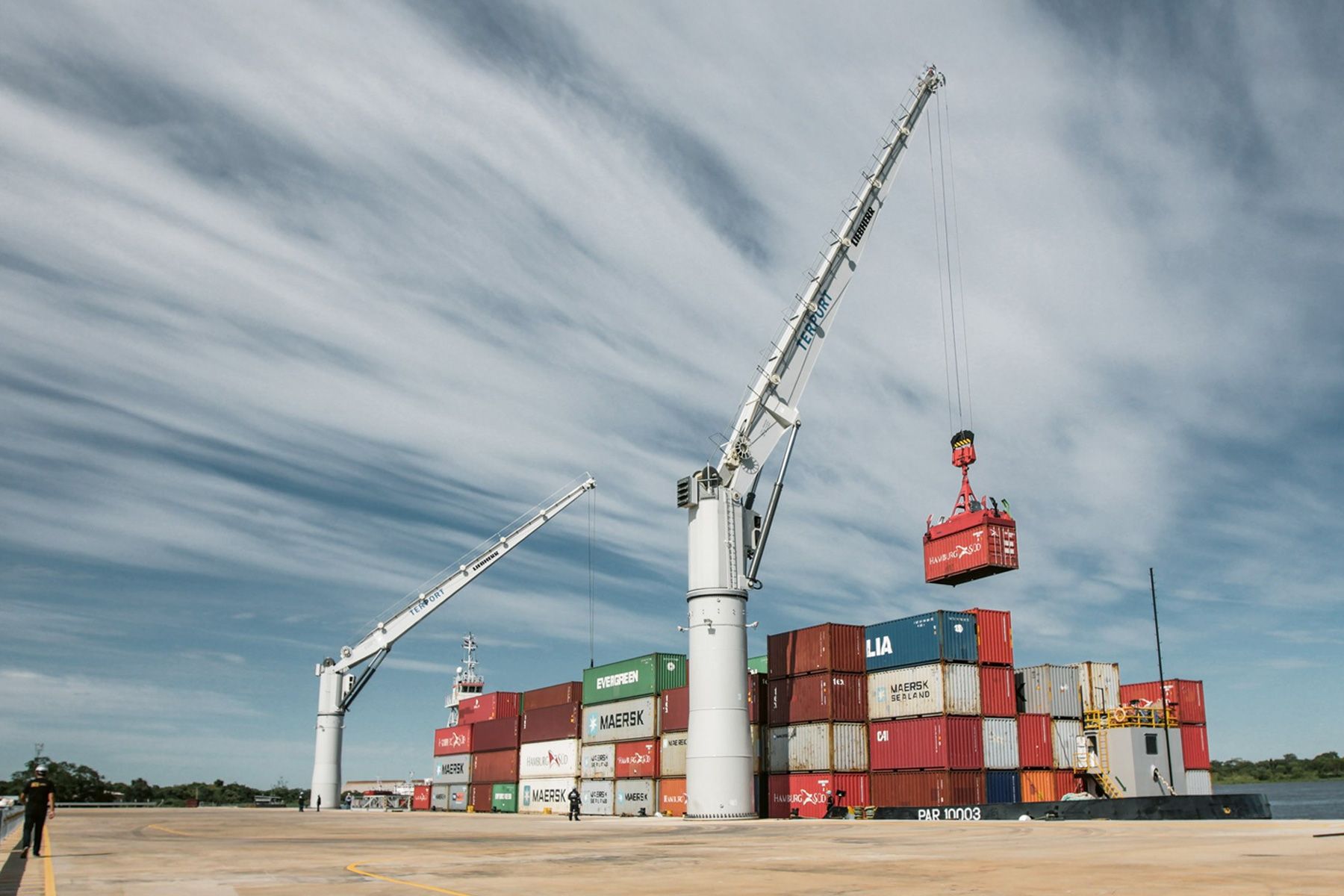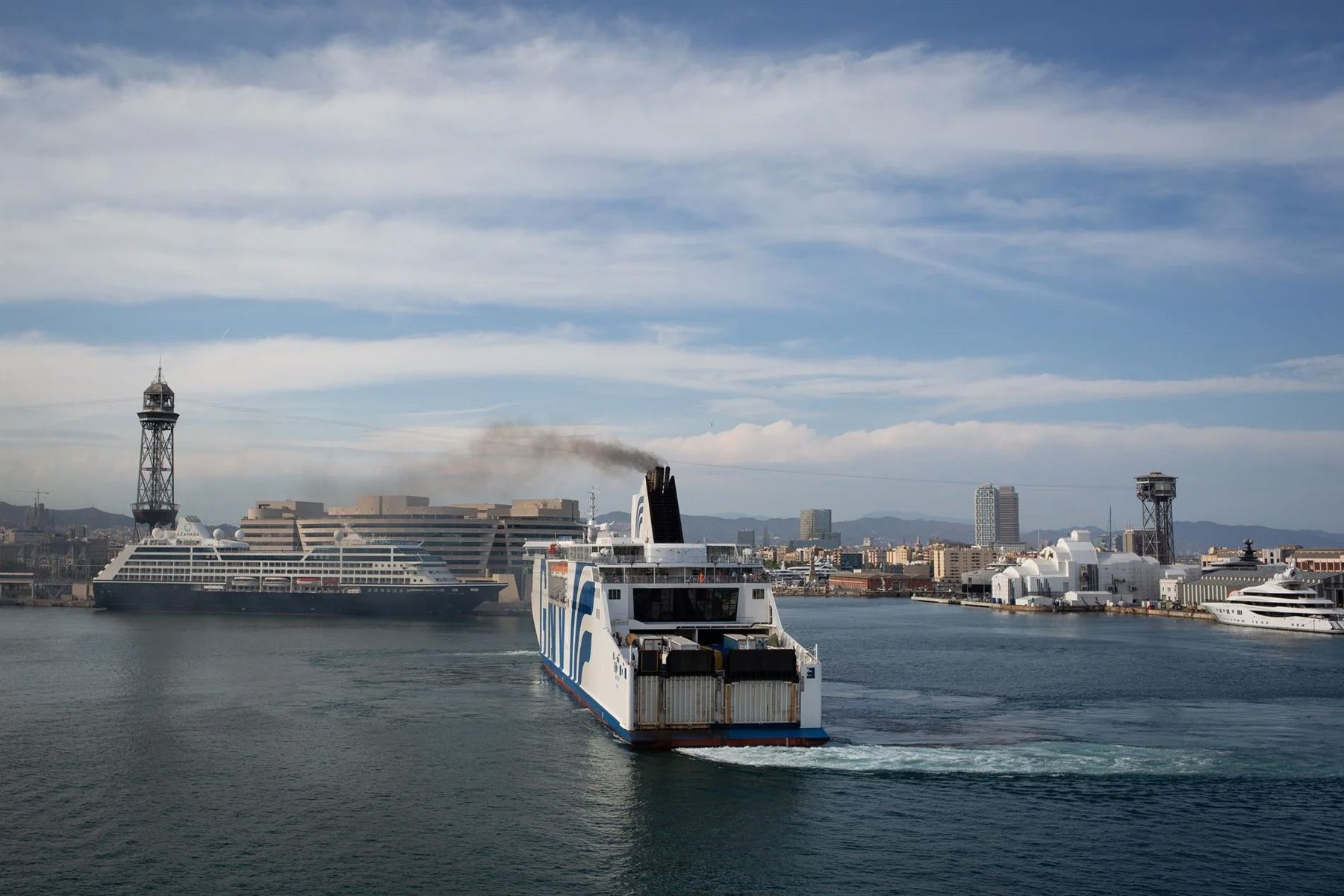HIGHLIGHTS
- Maritime transport is a fundamental asset in the global economy.
- Cruise traffic generates billions in revenue but also significant emissions.
- The main emissions are SO2, NOx, particulate matter (PM)Atmospheric particulate matter are microscopic elements suspended in the air, consisting of solid and liquid substances. They have a wide range of sizes an...
Read more and noiseImagine waking up every morning at 5:00 a.m. to the relentless roar of a motorway just metres from your window. Experiencing such high-intensity noise is n...
Read more. - Real-time monitoring with IoT sensors is the most efficient control measure.
Maritime transport is one of the pillars of the global economy. Ports drive trade, employment and connectivity between territories, but they also concentrate intense industrial activity that carries an environmental cost: air pollution.
For those responsible for environmental and sustainability matters in ports, air qualityAir quality refers to the state of the air we breathe and its composition in terms of pollutants present in the atmosphere. It is considered good when poll...
Read more is not just a technical indicator: it is an indicator of reputation, compliance and environmental leadership. Meeting European regulations, reducing emissions and communicating results transparently are now strategic factors that set a competitive port apart from one that falls behind.
Port activity: a brief context
According to Martin Dorsman, Secretary General of ECSA, “maritime transport is one of Europe’s most valuable assets”. In 2018 alone, its contribution to the European GDP was €54 billion and it generated two million direct and indirect jobs.
“Shipping is a cornerstone of Europe’s energy security and supply chains, and it is at the forefront of the energy transition. European shipping is a success story. Europe accounts for 35% of the world fleet compared to the EU’s 15% share of global GDP.”
Sotiris Raptis, Secretary General of ECSA (European Community Shipowners’ Associations)
Cruise traffic in Spain continues to break records. In 2024 it surpassed 12.8 million passengers, and in 2025 growth remains above 15%. This flow of travellers generates thousands of annual operations in major tourist ports such as Barcelona, the Balearic Islands or Palma, with an economic impact that exceeds €6 billion and tens of thousands of direct and indirect jobs.
Air Quality Innovation in Just 1 Click
Stay informed about the air you breathe!
Subscribe to our newsletter to receive the latest updates on environmental monitoring technology, air quality studies, and more.
However, this economic dynamism has a downside: rising emissions and deteriorating air quality.
Air quality in ports: the impact of maritime traffic
European maritime transport remains a major emitter of pollutants. According to the EMTER 2025 report by the European Maritime Safety Agency (EMSA), in 2022 ships operating in Europe emitted 137.5 million tonnes of CO2, with 70 % reductions in SOx, but 10 % increases in NOx and a doubling of methane (CH4)Methane, known chemically as CH₄, is a gas that is harmful to the atmosphere and to living beings because it has a high heat-trapping capacity. For this ...
Read more emissions since 2018. This gas now accounts for 26 % of methane from European transport and can be released up to 20 times more in areas of intense maritime traffic, as indicated by a study from Chalmers University of Technology (2025).
These emissions contribute to respiratory diseases, acid rain and cardiovascular problems, and they also affect marine biodiversity through underwater noise. Projects such as CORE LNGas hive and the OPS Master Plan aim to reverse this situation through cleaner fuels and shore-side electrification.
Why is port air quality a strategic issue?
Seaports concentrate ships, lorries, machinery and logistics activities. This industrial ecosystem generates an environmental footprint that demands control and transparency. Improving air quality is therefore a priority not only environmentally, but also strategically and economically.
Environmental and social impact of maritime traffic
Ships emit sulphur oxides (SO2), nitrogen oxides (NOx) and particulate matter (PM), among other pollutants, which can cause respiratory and cardiovascular disease. In addition, noise pollution affects marine fauna and the wellbeing of port communities.
Beyond health, these emissions damage the institutional reputation of ports in the eyes of citizens and institutions. In a context where sustainability is synonymous with competitiveness, transparency of environmental data has become a trust-building tool.
The role of port authorities
Port authorities play a key role in the transition to a more sustainable maritime model. In addition to managing logistics, safety and operational efficiency, they are responsible for ensuring compliance with an increasingly demanding environmental regulatory framework.
- Directive 2024/2881 sets pollutant concentration limits and requires reliable, comparable measurement systems at European level.
- The CEN/TS 17660 standard reinforces this commitment by requiring sensor validation and calibration to ensure that collected data are accurate and auditable.
- For its part, Annex VI of the IMO MARPOL Convention sets the global 0.5% sulphur cap in marine fuels, a key measure to reduce SO2 emissions in port environments.
For port environmental managers, meeting these regulations is not just a legal obligation: it is an opportunity to lead with transparency and technical rigour. Having real-time, traceable and certified data makes it possible to anticipate penalties, improve decision-making and strengthen institutional credibility with ministries, organisations, the public and sustainability-minded investors.

Maritime transport is one of the pillars of the global economy, but its environmental impact must be managed with technical rigour and social commitment.
Main sources of pollution in ports
Ports bring together a wide variety of industrial and logistics activities which, although essential to the global economy, are also significant sources of air pollution. Understanding where emissions come from is the first step towards controlling them effectively and moving towards more sustainable management models.
Emissions from ships and fossil fuels
The main source of port emissions comes from ships that berth, manoeuvre or remain on standby within the port area. Most run on heavy fuel oil, a high-sulphur fuel whose combustion releases sulphur oxides (SOx), nitrogen oxides (NOx), carbon monoxide (CO)The carbon monoxide (CO) is an invisible gas (colorless and odorless) that, at the same time, is a silent killer because in just a few minutes it exhibits ...
Read more and carbon dioxide (CO2)Carbon dioxide (CO2) is a gas that occurs naturally in the atmosphere and plays a crucial role in the life processes of the planet. This gas, also known as...
Read more. These substances contribute to acid rain, climate change and the formation of fine particles that affect the health of coastal communities.
To mitigate this impact, the International Maritime Organization (IMO) established the IMO 2020 regulation, which limits the sulphur content in marine fuels to 0.5% globally. This measure has driven the use of cleaner fuels, the installation of exhaust gas cleaning systems (scrubbers) and the development of more efficient, sustainable propulsion technologies.
Operational activity: loading, unloading and heavy machinery
Daily port operations such as cargo handling, storage, internal transport and maintenance generate a set of diffuse sources that affect air quality. The loading and unloading of bulk materials raise dust and particles, while the constant movement of lorries, cranes, forklifts and diesel machinery produces NOx, SO2 and environmental noise.
These pollutants build up particularly in areas of heavy traffic or with little natural ventilation, affecting both port staff and nearby urban areas. Implementing continuous monitoring systems makes it possible to identify these critical zones and apply specific corrective measures, such as predictive machinery maintenance or partial electrification of equipment.

Operations such as cargo handling, storage and transport generate emissions that affect air quality.
Port construction and maintenance
Expansion works, dredging or infrastructure repairs are another significant source of air pollution in port areas. During dredging, seabed sediments are stirred up, releasing fine particles and accumulated pollutants. Added to this are discharges of construction waste, fuel use in heavy machinery and a temporary increase in ambient noise.
Sound environmental management that combines discharge control, reduced machinery emissions and real-time monitoring can minimise the impact of these projects on coastal ecosystems and air quality.
Types of pollution generated by ships
Ship engines and port vehicles emit large amounts of NOx, which contribute to the formation of photochemical smogSmog, beyond that dense fog
Smog is a mixture of air pollutantsAir pollution caused by atmospheric contaminants is one of the most critical and complex environmental problems we face today, both because of its global r...
Read more that accumulate in the atmosphere, especially in urban areas. This phenomenon is character...
Read more, acid rain and various respiratory problems. These gases also promote the eutrophication of coastal ecosystems and play a role in global warming processes.
Sulphur oxides (SOx)
The combustion of fuels with a high sulphur content produces SOx, gases that degrade air quality and act as precursors of acid rain. In addition to affecting visibility and corroding buildings, SOx damage forests and marine ecosystems. Compliance with the IMO 2020 regulation, which limits the sulphur content in marine fuels to 0.5%, has been a key step in reducing these emissions.
Methane (CH4)
Methane is a greenhouse gas with a global warming potential more than 25 times higher than CO2. Although traditional ships emit it in small amounts, the increasing use of liquefied natural gas (LNG) as a marine fuel has raised concerns about unburned methane leaks during transport and combustion operations. This phenomenon, known as methane slip, offsets part of the environmental benefits associated with LNG. Monitoring and quantifying these emissions is essential to ensure that the energy transition in maritime transport is truly sustainable.
Suspended particles (PM1, PM2.5, PM10)
Suspended particles, such as soot, ash or dust, are among the most harmful pollutants for human health. Their microscopic size allows them to penetrate the lungs and bloodstream. A study by Johns Hopkins University (Kennedy, 2019) revealed that cruise ship decks show particle concentrations comparable to those of highly polluted cities such as Beijing. In addition, fine particles reduce visibility and contribute to the formation of secondary aerosols in the atmosphere.
Odours and volatile organic compounds
In addition to gases and particles, odours are one of the most perceptible and often contentious forms of air pollution in port areas.
Their origin usually lies in the emission of volatile organic compounds (VOCs) and reduced sulphur compounds such as hydrogen sulphide (H2S), mercaptan (CH4S) or ammonia (NH3)Invisible yet powerful: ammonia (NH3) is a colourless gas which, although naturally present in the atmosphere in small amounts, can become an unwelcome ene...
Read more, released during the handling of fuels, oils, industrial waste or bulk goods.
Although their impact does not always pose a direct health risk, episodes of intense odour generate discomfort, complaints from residents and loss of trust in port authorities. In many coastal cities, odour conflicts have become one of the main reputational and environmental communication challenges.
Odours also act as early indicators of fugitive emissions of polluting gases or leaks in storage systems. For this reason, an increasing number of ports are integrating networks of gas and odour sensors along with meteorological systems to identify the direction and source of emission hotspots.
Noise pollution
Noise from machinery, loading, unloading and maritime traffic affects both the wellbeing of port workers and the behaviour of marine fauna. Low-frequency sounds can interfere with the communication and orientation of cetaceans, fish and coastal birds. In a sustainable port, noise management should be addressed alongside the control of gases and particles through acoustic monitoring technologies and comprehensive mitigation plans.
Hydrocarbons and spills
Accidental spills or deliberate discharges of hydrocarbons alter marine ecosystems, reduce biodiversity and contaminate coastal waters and sediments. Added to this are non-methane volatile organic compounds (NMHCs), which are released during the handling of fuels, paints or solvents. These compounds contribute to the formation of tropospheric ozone and exacerbate photochemical pollution in densely populated port areas.
Controlling and preventing both hydrocarbon spills and NMHC emissions is crucial to preserving the health of marine ecosystems and protecting air quality in urban areas near ports.

Port emissions not only degrade the air: they impact the port’s reputation and its social licence to operate.
Pollution-generating activities in ports
Ports, vital for global trade, are also major sources of pollution due to various activities inherent to their operation. Here are some of the most impactful ones:
Loading and unloading operations
Loading and unloading operations are critical processes in transport logistics, but they are not without environmental consequences. During these activities, the constant movement of goods emits harmful particles and gases into the air. These emissions not only include dust that can deteriorate local air quality but also greenhouse gasesWhile the concentration of carbon dioxide (CO2) in the atmosphere has been steadily and rapidly increasing in recent decades, in May 2025, CO2 surpassed 43...
Read more that have long-term implications, such as rising global temperatures and altered climate patterns. Therefore, these operations are significant contributors to climate change, an environmental challenge we face worldwide.
Heavy vehicle traffic
Energy generation and machinery use
Energy generation and the use of machinery in ports are essential activities for trade and the maritime industry. However, these processes have a less favourable side. Port equipment and docked ships largely depend on fossil fuels, an energy source that, when burned, releases carbon dioxide (CO2) and various other pollutants into the atmosphere. These emissions not only contribute to the greenhouse effect, intensifying global warming, but are also responsible for the acidification of our oceans. This phenomenon alters the chemical balance of seawater, which can have devastating consequences for marine life and the ecosystems that depend on it.
Vessel maintenance and cleaning
Vessel maintenance and cleaning are essential tasks to ensure the operability and safety of ships. However, these practices can have a dark side from an environmental perspective. Cleaning ship tanks and hulls releases toxic substances into the aquatic environment. These often harmful chemicals disperse in the water, polluting marine ecosystems and adversely affecting aquatic life. From habitat alteration to direct harm to marine organisms, the impacts of these cleaning activities are significant and pose major challenges for marine conservation.
Port construction and expansion activities
Port construction and expansion activities are essential for maritime infrastructure development and economic growth. However, these civil works, including dredging, have a significant environmental impact. Removing sediments from the seabed not only releases previously deposited contaminants but also alters marine habitats. The resulting turbidity can have adverse effects on aquatic species, from reducing the sunlight needed for photosynthesis to disrupting feeding and reproduction processes. These human interventions require careful planning and management to minimise their impact on delicate marine ecosystems.
Overall, these activities, if not properly managed, can have long-lasting harmful effects on the environment and human health. Therefore, it is essential to implement sustainable practices and clean technologies to reduce the environmental footprint of ports. Process optimisation and strict regulation are key to ensuring a greener future for the port industry.
Want to monitor the impact of port activities on air quality?
Download the technical report [PDF] on the air quality monitoring network deployed in the ports of the Balearic Islands.
Consequences of pollution in ports
Air pollution in port environments is not only an environmental issue: it represents a comprehensive risk that affects public health, economic stability and the institutional reputation of port authorities.
These impacts translate into constant pressures: ensuring regulatory compliance, maintaining the trust of regulatory bodies and preserving the port’s image in the eyes of the public. The effects are broad and cumulative:
Effects on health and the urban environment
Urban areas close to ports directly suffer the consequences of pollution. High levels of NO2, SO2, fine particles and volatile organic compounds (VOCs) lead to an increase in asthma, chronic bronchitis and cardiovascular diseases among the population. Port workers, constantly exposed, face a higher risk due to the concentration of pollutants in operational zones with poor ventilation.
In addition, the accumulation of dust, noise and gases creates environmental stress that deteriorates quality of life and accelerates urban degradation, particularly in neighbourhoods adjacent to loading and unloading areas.
Risk to institutional reputation
Beyond impacts on health and the environment, port pollution can erode the institutional credibility of authorities. Neighbourhood conflicts caused by dust, noise or unpleasant odours often escalate quickly and attract media attention, affecting the public perception of the port as a responsible economic driver.
Reactive management is no longer sufficient. Citizens and international organisations now demand verifiable data, transparent communication and visible action. Implementing continuous monitoring systems and publishing results on open dashboards helps demonstrate real commitment and prevent reputational crises.
Poor air quality not only leads to environmental problems but also to loss of trust, regulatory sanctions and operational overruns that compromise the port’s competitiveness.

Air quality control at the Port of Bilbao – Kunak
How to improve air quality in ports: from measurement to action
Ensuring air quality in ports is a complex challenge that requires a combination of technology, planning and environmental commitment. Port authorities must move from reactive strategies to management based on real-time data, integrating continuous monitoring into their sustainability and compliance policies.
Continuous monitoring as a management tool
Spot or manual measurements are no longer sufficient to address current challenges. IoT environmental monitoring networks, such as Kunak AIR Pro stations, make it possible to measure gases and particles in real time with high precision, remote calibration, traceable data and cloud connectivity.
Unlike traditional fixed stations, these networks are modular, scalable and more affordable, enabling large port areas to be covered and variations in pollution to be detected with high temporal and spatial resolution.
With advanced systems such as Kunak AIR Pro and the Kunak AIR Cloud platform, port authorities can:
- Detect emission sources before they cause conflicts or breaches.
- Set up automatic alerts and immediate action plans.
- Generate automatic, customised regulatory reports.
- Communicate results to the public through open dashboards or public widgets.
Success story: the Port Authority of the Balearic Islands installed 25 Kunak AIR stations to monitor pollution and noise in five ports across the Balearic Islands, establishing a model of a smart, transparent and sustainable port.
Check the Ports de Balears air quality widget for real-time data from the Kunak station network.
Data integration and ESG reporting
Modern environmental management goes beyond measurement: it requires interpreting data and transforming it into strategic decisions. The Kunak AIR Cloud platform centralises all station data and integrates it with meteorological, energy and operational systems within the port.
Thanks to this interoperability, environmental managers can:
- Calculate key performance indicators (KPIs) aligned with ISO 14001 and ISO 50001.
- Generate ESG (Environmental, Social & Governance) reports automatically.
- Analyse historical trends and assess the effectiveness of corrective measures.
- Identify activities or vessels responsible for high pollution episodes.
Continuous monitoring also allows emissions to be correlated with meteorological conditions or levels of maritime traffic, providing a comprehensive view of the port and improving responsiveness during pollution events.
Other complementary mitigation measures
Monitoring technology is the starting point, but it must be accompanied by structural policies and solutions that reinforce its effectiveness:
- Quay electrification (shore power) to reduce emissions from moored vessels.
- Gradual replacement of fossil fuels with low-carbon options or biofuels.
- Installation of scrubbers with responsible environmental management, avoiding the discharge of waste into the sea.
- Collaboration with universities and European projects on environmental innovation and energy transition.
Together, these measures help build a sustainable port model, capable of reducing its environmental impact without compromising operational efficiency.

Port electrification is key to decarbonising maritime transport and reducing air and noise pollution. Source: Forbes
Ports already using Kunak technology
Several leading international ports already use Kunak technology to monitor and reduce emissions, reinforcing their commitment to sustainability and transparency:
- Ports of the Balearic Islands (Spain) – Network of 25 stations for air and noise control.
- Port of Dunkirk (France) – Continuous monitoring of industrial pollutants.
- Port of Le Havre (France) – Integrated environmental monitoring network.
- Port of Neom (Saudi Arabia) – Advanced measurement system for expansion zones.
- Port of Cotonou (Benin) – Environmental monitoring through a sensor network.
- Port of Brisbane (Australia) – Monitoring in high maritime traffic environments.
- Port of Antwerp-Bruges (Belgium) – Environmental monitoring network.
- Port of Genoa (Italy) – Monitoring of gases and particles in nearby urban areas.
- Port of Bilbao (Spain) – Monitoring of diffuse particle emissions.
- Port of the Bay of Cádiz (Spain) – Environmental control and atmospheric impact forecasting.
- Port of Almería (Spain) – Assessment of pollutant dispersion and its urban impact.
These examples demonstrate that environmental digitalisation is already a reality in the world’s most innovative ports, paving the way for a new generation of sustainable and connected ports.

Air quality control at the Port of Dunkirk – Kunak
Air quality widget of the Balearic Islands Port Authority
Information panel on air quality at the Port of Palma de Mallorca, managed by Ports de Balears, showing data provided by the Kunak air quality station network.
Frequently asked questions (FAQs)
Which air pollutants are measured in a port?
Ports mainly monitor sulphur dioxide (SO2), nitrogen dioxide (NO2), carbon monoxide (CO), ozone (O3), ammonia (NH3), hydrogen sulphide (H2S) and particulate matter (PM1, PM2.5, PM10). These parameters make it possible to assess the impact of maritime and land operations on air quality.
How do ship emissions affect coastal cities?
Gases and particles emitted by vessels can move from the port area into urban zones, especially under adverse meteorological conditions. This raises pollution levels, contributes to the formation of photochemical smog and increases the risk of respiratory and cardiovascular problems among the population.
Which regulations govern air quality in ports?
Key references include the European Directive 2024/2881 on air quality, the CEN/TS 17660 technical specification for sensor validation, and Annex VI of the MARPOL Convention of the International Maritime Organization (IMO), which regulates the sulphur content of marine fuels.
What technologies are used to measure air quality?
High-precision electrochemical and optical sensors are used, integrated into IoT environmental monitoring networks. Equipment such as Kunak AIR Pro provides accuracy, remote calibration, real-time alarms and traceable data, in line with international reference standards.
What are the benefits of an intelligent monitoring network?
An intelligent network enables real-time source detection, prevention of environmental incidents, regulatory compliance and reduced maintenance costs. It also delivers public transparency through open dashboards, strengthening trust among port authorities, regulators and citizens.
Conclusion
Ports are engines of economic progress and pillars of global trade, but they are also centres of activity where emissions and environmental impact must be managed with technical rigour and social commitment. In a context where sustainability has become a marker of competitiveness, improving air quality is not only about compliance: it is about leading change.
Continuous monitoring and real-time, traceable data allow port authorities to anticipate problems, reinforce transparency and communicate their progress credibly. In this way, technological innovation becomes a strategic tool to protect health, strengthen institutional reputation and build public trust.
Turning a port into a Green Port is not only about reducing emissions; it is also about gaining trust, reputation and a future.
With the support of solutions such as Kunak AIR Pro and Kunak AIR Lite monitoring stations and the Kunak AIR Cloud air-quality software, ports can turn environmental challenges into opportunities for innovation, efficiency and sustainable leadership, steering towards a cleaner, smarter and more responsible future.
Discover how Kunak helps port authorities measure, manage and improve air quality in real time. See more here.
Sources consulted
- Kennedy, R. D. (2019). An investigation of air pollution on the decks of 4 cruise ships. Stand.earth. Johns Hopkins Bloomberg School of Public Health. https://www.stand.earth/sites/default/files/2019-an-investigation-of-air-pollution-on-the-decks-of-4-cruise-ship.pdf
- Tang, L., Ramacher, M. O. P., Moldanová, J., Matthias, V., Karl, M., & Johansson, L. (2020). Impact of ship emissions on air quality and human health in the Gothenburg area. Atmospheric Chemistry and Physics Discussions. https://doi.org/10.5194/acp-2020-94
- Ruiz-Guerra, I., Molina-Moreno, V., Cortés-García, F., & Núñez-Cacho, P. (2019). Prediction of the impact on air quality of cities receiving cruise tourism: the case of the Port of Barcelona. Heliyon, 5(3), e01280. https://doi.org/10.1016/j.heliyon.2019.e01280
- European Environment Agency (EEA). (2022). Air pollution and NH3 emissions report. https://www.eea.europa.eu/publications/air-quality-in-europe-2022
- Wang, L., Sun, J., Zhang, Y., & Andersson, P. (2025). Marine traffic intensifies subsea methane emissions in coastal European waters. Communications Earth & Environment, 6(1), Article 2344. https://doi.org/10.1038/s43247-025-02344-8








